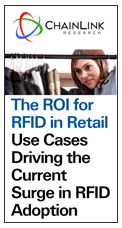|
New ChainLink Research Report Assesses
Surge
in Retail RFID Adoption
Improved Inventory Accuracy Number One Driver for
Implementation Today
 NEUHAUSEN,
Switzerland — January 13, 2014 — Tyco Retail Solutions (www.tycoretailsolutions.com),
a leading provider of retail performance and security solutions, today announced
the results of a new, sponsored ChainLink Research report: Use Cases Driving the
Current Surge in RFID Adoption. The ChainLink Research team surveyed and
interviewed over 120 retailers from the Americas and Europe to explore the
resurgence of interest and substantial growth in the use of RFID in retail. When
asked to rank the three top reasons for implementing RFID now, retailers noted: NEUHAUSEN,
Switzerland — January 13, 2014 — Tyco Retail Solutions (www.tycoretailsolutions.com),
a leading provider of retail performance and security solutions, today announced
the results of a new, sponsored ChainLink Research report: Use Cases Driving the
Current Surge in RFID Adoption. The ChainLink Research team surveyed and
interviewed over 120 retailers from the Americas and Europe to explore the
resurgence of interest and substantial growth in the use of RFID in retail. When
asked to rank the three top reasons for implementing RFID now, retailers noted:
| 1. Improving inventory accuracy |
| 2. Reducing out of stocks (OOS) |
| 3. Increasing on-floor availability |
 The report describes the improvement opportunity, as measured by previous
research: When compared to traditional manual bar code scanning, RFID enables
cycle counting to be done up to 25 times faster. Frequent, accurate cycle
counting improves inventory accuracy, typically by 20% - 30%, allowing a number
of retailers to achieve 99% inventory accuracy. This enables replenishment
alerts to be reliably generated, which decreases out-of-stocks, typically by
15%-30% and increases on-floor availability. The research revealed that almost
all of the retailers that are progressing with widespread RFID rollouts have
seen a sales uplift in the categories where they implemented item-level RFID.
This was primarily due to a reduction in out-of-stocks, driven by dramatic
improvements in inventory accuracy that RFID brings. The report describes the improvement opportunity, as measured by previous
research: When compared to traditional manual bar code scanning, RFID enables
cycle counting to be done up to 25 times faster. Frequent, accurate cycle
counting improves inventory accuracy, typically by 20% - 30%, allowing a number
of retailers to achieve 99% inventory accuracy. This enables replenishment
alerts to be reliably generated, which decreases out-of-stocks, typically by
15%-30% and increases on-floor availability. The research revealed that almost
all of the retailers that are progressing with widespread RFID rollouts have
seen a sales uplift in the categories where they implemented item-level RFID.
This was primarily due to a reduction in out-of-stocks, driven by dramatic
improvements in inventory accuracy that RFID brings.
According to Ann Grackin, CEO of ChainLink Research, “RFID has come a long way
in the last few years. Standards have been established. Prices for systems and
tags have plummeted. RFID technology has become much more reliable. Software
applications that can be integrated into retailer IT systems and that are
user-friendly at the store level are now available. There are many more
experienced implementers, technologies have evolved into a complete solutions
approach and technology providers and systems integrators have considerably
greater experience with retail and integration with operational systems.”
Many of the challenges traditionally associated with RFID have been addressed by
advancements in technology. This emphasizes the importance of selecting the
right solution and experienced RFID implementation partners who have faced,
understand, and overcome the challenges from the ‘physics of RFID.’
The report describes the statistics and details from the survey, including why
retailers are implementing RFID now and how they are using the technology. While
RFID is primarily gaining adoption for inventory management applications, when
retailers were asked to list all the RFID use cases they envision being
implemented in their chains in the future, loss prevention and specifically RFID
at the store exit, surfaced as the top response. In most cases, this anticipated
use of RFID for Loss Prevention is in combination with an RFID for inventory and
replenishment. However, results indicate that retailers are investigating how
RFID technology can provide item-level shrink visibility not available until
now.
As RFID implementations are evolving, the research team also sought to learn
more about lessons learned from projects that stalled or were cancelled. When
asked why an RFID program was cancelled or halted, respondents cited lack of
well-defined use cases, lack of executive support, and other competing business
priorities as their top reasons. This finding underscores the importance of
selecting use cases and deployment plans that yield the most rapid ROI, so that
benefits are large enough to win against competing uses of capital and other
initiatives that consume management attention.
One common thread among successful implementations is they usually start with
the area of fastest ROI. According to the report, for most retailers, this is a
focus on products with “High Mix Complexity,” such as size/color/style
-intensive items in apparel and footwear, inkjet cartridges, certain cosmetics,
fragrances, and certain sporting goods. What these categories have in common is
the need to keep many different variations on display, so that when a customer
walks in the door, the right product, and color and size, is in the right place
at the right time. The primary driver here is an increase in sales resulting
from on-floor inventory availability and out of stock reduction. RFID helps
increase inventory accuracy and timely replenishment alerts to drive these
results.
“Recently, retailers like Macy’s, Walmart, Saks and others have implemented RFID
on billions of items. As a result, they are realizing a sizeable operational,
financial, and customer satisfaction advantage over competing retailers who are
not using RFID. If you are one of those competing retailers, you should probably
be taking a serious look at implementing RFID now,” Ms. Grackin concluded.
Learn more about this new report, "The
ROI for RFID in Retail."
Contacts:
Sarah Murray
Attune Communications
+1 (781) 378-2674
sarah@attunecommunications.com
|